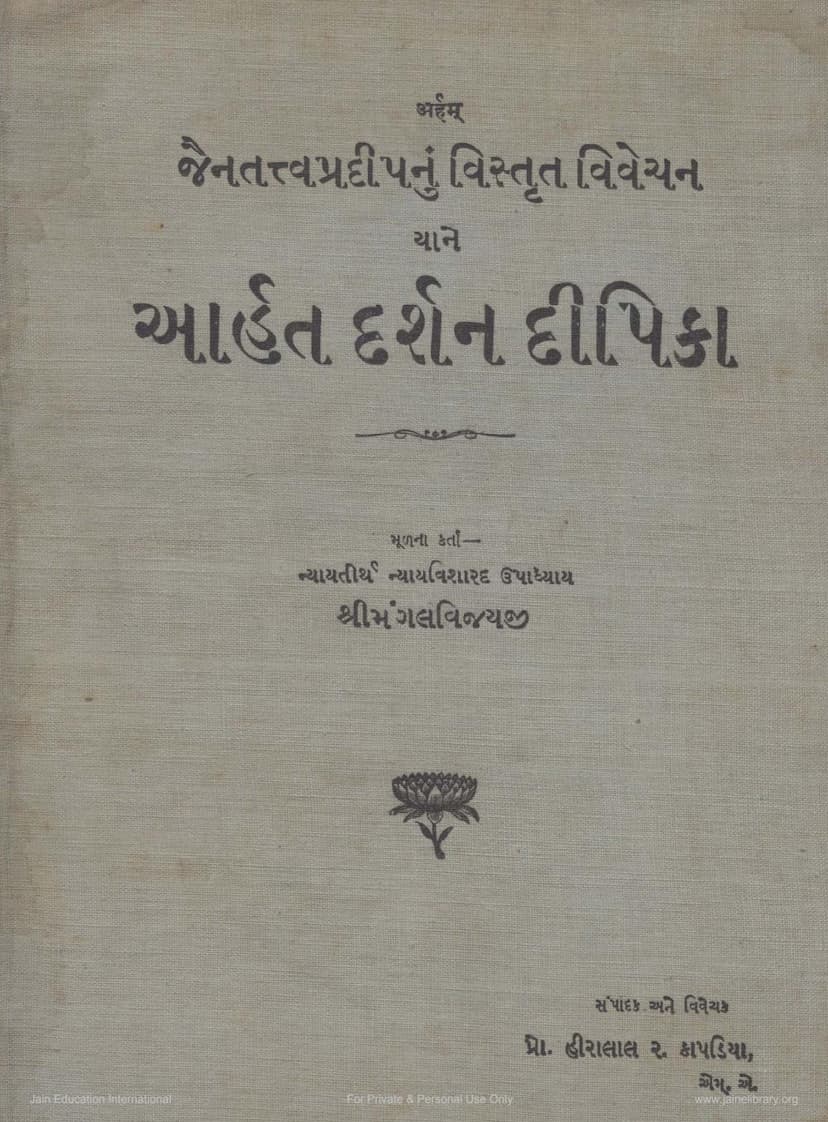Arhat Darshan Dipika
Added to library: September 1, 2025

Summary
Arhat Darshan Dipika: A Comprehensive Summary
Book Title: Arhat Darshan Dipika (એહત દર્શન દીપિકા) Author: Upadhyaya Shri Mangalvijayji (ઉપાધ્યાય શ્રી મંગલવિજયજી) Editor/Commentator: Prof. Hiralal R. Kapadia (પ્રો. હીરાલાલ ૨. કાપડિયા) Publisher: Shri Yasovijay Jain Granthamala, Bhavnagar (શ્રીયશોવિજય જૈન ગ્રન્થમાલા, ભાવનગર) Original Text: Jain Tattva Pradeep (જેન તત્ત્વ પ્રદીપ) by Upadhyaya Shri Mangalvijayji
Overview:
Arhat Darshan Dipika is a detailed critical commentary and Gujarati translation of Jain Tattva Pradeep, a foundational text authored by the learned Jain scholar Upadhyaya Shri Mangalvijayji. The work was meticulously compiled and edited by Prof. Hiralal R. Kapadia, a renowned scholar in Jain literature and ancient Indian studies. Published by Shri Yasovijay Jain Granthamala, the book aims to elucidate the core principles of Jain philosophy in a comprehensive and accessible manner.
Content and Structure:
The book is structured as a detailed exploration of Jain philosophy, delving into fundamental concepts and categorizations. The commentary meticulously explains the original text, providing clarification, context, and often comparative analysis with other philosophical schools. The provided text offers a glimpse into the extensive table of contents, revealing a systematic approach to understanding Jainism.
Key Themes and Concepts Explored (as indicated by the table of contents):
The book systematically breaks down Jain philosophy into several key "Ullases" (sections or chapters), primarily focusing on the nature of the soul (Jiva) and the principles of conduct and liberation. Key themes include:
-
The Soul (Jiva):
- Nature of the Soul: Explores the soul's fundamental characteristics, its relationship with consciousness (upayoga), bondage (bandha), and liberation (moksha).
- Soul's Existence and Attributes: Discusses the soul's pervasiveness, its dependence on the body, and its eternal nature, contrasting it with materialistic philosophies.
- Jiva's Classification: Details the soul's journey through various states of existence and its interaction with karmic matter.
- Upayoga (Consciousness/Activity): Analyzes the nature of consciousness and its manifestations in Jainism.
-
Ajeeva (Non-Soul) and the Seven Tattvas:
- Dravyas (Substances): A detailed examination of the six substances of Jainism (Jiva, Ajiva, Dharmastikaya, Adharmastikaya, Akashastikaya, and Pudgala) is presented, highlighting their characteristics and interactions.
- The Seven Tattvas: The text systematically explains the seven fundamental realities (tattvas) of Jainism: Jiva, Ajiva, Asrava, Bandha, Samvara, Nirjara, and Moksha. The commentary likely elaborates on their causes, effects, and the path to liberation.
- Pudgala (Matter): Explores the nature of matter, its atomic structure (paramanu), and its various permutations and combinations (skandhas).
- Dharmastikaya, Adharmastikaya, Akashastikaya, and Kalastikaya: Explains the nature and function of these auxiliary substances that facilitate movement, rest, space, and time respectively.
-
Bondage and Liberation:
- Asrava (Influx of Karma): Analyzes the causes of karmic influx, including the role of the senses, passions (kashayas), and activities (yoga).
- Bandha (Bondage): Discusses the process of karma binding to the soul and its various types and durations.
- Samvara (Stoppage of Karma): Explores the practices and principles that lead to the cessation of karmic influx, including the five samitis (carefulness in conduct) and three guptis (restraint of mind, speech, and body).
- Nirjara (Shedding of Karma): Details the methods for shedding accumulated karma, primarily through austerities (tapas) and virtuous conduct.
- Moksha (Liberation): Elucidates the ultimate goal of Jainism, the state of liberation from the cycle of birth and death, achieved through the attainment of the three jewels (Samyak-darshan, Samyak-gyan, and Samyak-charitra).
-
Pramanas and Nayaloka (Means of Knowledge and Standpoints):
- Pramanas (Means of Valid Knowledge): Analyzes the Jain epistemological framework, primarily focusing on perception (pratyaksha) and inference (anumana), and potentially others like authority (agama). The commentary delves into the subtleties of these concepts, often contrasting them with other Indian philosophical systems.
- Nayals (Standpoints): Explores the concept of nayas, which are different perspectives or standpoints from which reality can be understood. The text highlights the importance of understanding these diverse viewpoints to grasp the multifaceted nature of reality, as central to Jain philosophy's Anekantavada (many-sidedness).
-
Conduct and Ethics:
- Vows (Vratas): The text likely discusses the five great vows (Mahavratas) for ascetics and the five minor vows (Anuvratas) for lay followers, along with their sub-categories and ethical implications.
- Austerities (Tapas): Explores the significance and types of austerities undertaken for spiritual purification and karmic shedding.
- Virtues: Discusses the cultivation of virtues like non-violence (ahimsa), truthfulness (satya), non-stealing (asteya), celibacy (brahmacharya), and non-possession (aparigraha).
-
Leśyā (Subtle Karmic Dispositions):
- Explains the six subtle karmic dispositions (krishna, neela, kapota, tejas, padma, and shukla) that influence the soul's state and its experience of karma. The text likely provides detailed descriptions of their characteristics, manifestations, and their impact on the soul's journey.
Commentary and Scholarly Value:
Prof. Hiralal R. Kapadia's commentary is highly praised for its depth, clarity, and scholarly rigor. He meticulously analyzes the original text, referencing other Jain scriptures and philosophical works to provide a comprehensive understanding of Upadhyaya Mangalvijayji's exposition. The editor's footnotes, cross-references, and comparative insights add significant value for scholars and practitioners alike. The catalog link indicates the book is a significant contribution to Jain literature research.
Target Audience:
Arhat Darshan Dipika is intended for individuals seeking a deep and scholarly understanding of Jain philosophy. It caters to students of Jainism, researchers, and anyone interested in the intricacies of its metaphysical and ethical principles.
Significance:
This work is a valuable resource for understanding the nuances of Jain Tattva (reality) as presented by Upadhyaya Shri Mangalvijayji and elucidated by Prof. Kapadia. It serves as a bridge between ancient Jain texts and contemporary philosophical inquiry, making complex concepts accessible through detailed explanation and critical analysis. The book underscores the Jain emphasis on rational inquiry, philosophical depth, and the meticulous classification of spiritual principles.